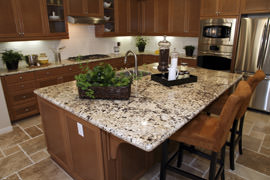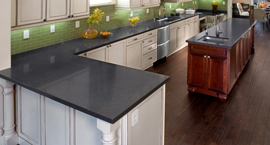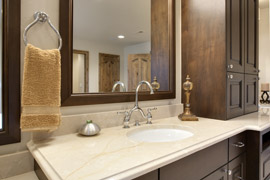Unsure which stone is right for you? Below is a quick summary of the natural stones differences and similarities which may help with your choice. Read further down the page for more detailed technical information on each type of stone….
The differences (and similarities) of granite, marble and quartz.
They are all stone, which makes them hard, heavy, and must be installed by experienced professionals. They are natural products, which means there can be variations in color and pattern, and sometimes what you see in the display/sample is not exactly what you get delivered with granite and marble – you should view your slab. Quartz is predictable with its colour and pattern so the samples are what you will get. All come in a wide range of colors, and patterns.
 Granite and marble can be stained by oily or highly colored foods. So both require resealing every once in a while (every 5 years). Both are relatively heatproof, and they won’t scorch – can withstand heat temperatures up to 1200F. Quartz does not require sealing and is heat-resistant up to 300F.
Granite and marble can be stained by oily or highly colored foods. So both require resealing every once in a while (every 5 years). Both are relatively heatproof, and they won’t scorch – can withstand heat temperatures up to 1200F. Quartz does not require sealing and is heat-resistant up to 300F.
If you are choosing between granite and marble – granite resists impacts and scratches better. And it is resistant to acids like tomato juice, lemon juice or vinegar. Marble is calcium carbonate, just like chalk, but in a compressed and crystallized form. So acids can etch the surface permanently. (And it will fizz, just like chalk in vinegar.) It also can scratch more easily. Some marbles have very little pattern so stains and marring stand out more.
 A marble countertop or slab is a traditional working surface for pastry chefs, because the cold stone keeps the butter in the pastry layers from melting. But polished granite would probably work as well.
A marble countertop or slab is a traditional working surface for pastry chefs, because the cold stone keeps the butter in the pastry layers from melting. But polished granite would probably work as well.
Practical considerations aside, marble has a look that is possibly more elegant and luxurious out of the three stones. It has extremely fine crystals, which create a snowy or satiny look. And the colors and patterns can be quite dramatic. Granite tends to have larger crystals, perhaps the size of peas or rice grains. This creates a coarser, more sparkly look. And while granite comes in a range of colors and patterns, that range is probably narrower than for marble.
 Granite is recommended for hard use areas like countertops. Marble is higher maintenance and used more often in bathrooms or low traffic areas. Its one advantage may be in appearance, but that will depend on the owner’s taste and the kitchen’s overall style.
Granite is recommended for hard use areas like countertops. Marble is higher maintenance and used more often in bathrooms or low traffic areas. Its one advantage may be in appearance, but that will depend on the owner’s taste and the kitchen’s overall style.
Quartz or “engineered stone” is less porous. It is made of quartz powder that is fused together at very high heat. Unlike granite, it resists stains and doesn’t need sealing. It comes in patterns and colors that mimic granite very closely, but it is totally predictable, and more uniform than real stone. It also comes in colors and patterns not found in nature, like bright blue so you have a vast choice when it comes to design options.
Technical Information
Granite
Is a common widely occurring type of intrusive, felsic, igneous rock which is granular and crystalline in texture. This rock consists mainly of quartz, mica, and feldspar. Occasionally some individual crystals (phenocrysts) are larger than the groundmass, in which case the texture is known as porphyritic. A granitic rock with a porphyritic texture is sometimes known as a porphyry. Granites can be pink to gray in color, depending on their chemistry and mineralogy. By definition, granite is an igneous rock with at least 20% quartz by volume. Granite differs from granodiorite in that at least 35% of the feldspar in granite is alkali feldspar as opposed to plagioclase; it is the alkali feldspar that gives many granites a distinctive pink color. Outcrops of granite tend to form tors and rounded massifs. Granites sometimes occur in circular depressions surrounded by a range of hills, formed by the metamorphic aureole or hornfels. Granite is usually found in the continental plates of the Earth’s crust.
Granite is nearly always massive (lacking internal structures), hard and tough, and therefore it has gained widespread use as a construction stone. The average density of granite is between 2.65 and 2.75 g/cm3, its compressive strength usually lies above 200 MPa, and its viscosity near STP is 3-6 • 1019 Pa·s. Melting temperature is 1215 – 1260 °C.
Occurrence
Granite is currently known only on Earth, where it forms a major part of continental crust. Granite often occurs as relatively small, less than 100 km² stock masses (stocks) and in batholiths that are often associated with orogenic mountain ranges. Small dikes of granitic composition called aplites are often associated with the margins of granitic intrusions. In some locations, very coarse-grained pegmatite masses occur with granite. Granite has been intruded into the crust of the Earth during all geologic periods, although much of it is of Precambrian age. Granitic rock is widely distributed throughout the continental crust and is the most abundant basement rock that underlies the relatively thin sedimentary veneer of the continents.
Origin
Granite is an igneous rock and is formed from magma. Granitic magma has many potential origins but it must intrude other rocks. Most granite intrusions are emplaced at depth within the crust, usually greater than 1.5 kilometers and up to 50 km depth within thick continental crust. The origin of granite is contentious and has led to varied schemes of classification. Classification schemes are regional and include French, British, and American systems.
Marble
Marble is a non-foliated metamorphic rock composed of recrystallized carbonate minerals, most commonly calcite or dolomite. Geologists use the term “marble” to refer to metamorphosed limestone; however, stonemasons use the term more broadly to encompass unmetamorphosed limestone. Marble is commonly used for sculpture and as a building material.
Origin
Marble is a rock resulting from metamorphism of sedimentary carbonate rocks, most commonly limestone or dolomite rock. Metamorphism causes variable recrystallization of the original carbonate mineral grains. The resulting marble rock is typically composed of an interlocking mosaic of carbonate crystals. Primary sedimentary textures and structures of the original carbonate rock (protolith) have typically been modified or destroyed.
Pure white marble is the result of metamorphism of a very pure (silicate-poor) limestone or dolomite protolith. The characteristic swirls and veins of many colored marble varieties are usually due to various mineral impurities such as clay, silt, sand, iron oxides, or chert which were originally present as grains or layers in the limestone.
Green coloration is often due to serpentine resulting from originally high magnesium limestone or dolostone with silica impurities. These various impurities have been mobilized and recrystallized by the intense pressure and heat of the metamorphism.
Quartz
Quartz is an abundant mineral in the Earth’s continental crust. It is made up of a continuous framework of SiO4 silicon–oxygen tetrahedra, with each oxygen being shared between two tetrahedra, giving an overall formula SiO2. There are many different varieties of quartz, several of which are semi-precious gemstones. Throughout the world, varieties of quartz have been, since antiquity, the most commonly used minerals in the making of jewelry and hardstone carvings.
Crystal Habit & Structure
Quartz belongs to the trigonal crystal system. The ideal crystal shape is a six-sided prism terminating with six-sided pyramids at each end. In nature quartz crystals are often twinned, distorted, or so intergrown with adjacent crystals of quartz or other minerals as to only show part of this shape, or to lack obvious crystal faces altogether and appear massive. Well-formed crystals typically form in a ‘bed’ that has unconstrained growth into a void, but because the crystals must be attached at the other end to a matrix, only one termination pyramid is present. There are exceptions as doubly terminated crystals do occur. An occurrence in Herkimer County, New York is noted for these Herkimer diamonds with terminations at both ends. A quartz geode is such a situation where the void is approximately spherical in shape, lined with a bed of crystals pointing inward.
Occurrence
Quartz is an essential constituent of granite and other felsic igneous rocks. It is very common in sedimentary rocks such as sandstone and shale and is also present in variable amounts as an accessory mineral in most carbonate rocks. It is also a common constituent of schist, gneiss, quartzite and other metamorphic rocks. Because of its resistance to erosion it is very common in stream sediments and in residual soils. Quartz, therefore, occupies the lowest potential to weather in the Goldich dissolution series.
Quartz occurs in hydrothermal veins as gangue along with ore minerals. Large crystals of quartz are found in pegmatites. Well-formed crystals may reach several meters in length and weigh as much as 1,400 pounds (640 kg).
Naturally occurring quartz crystals of extremely high purity, necessary for the crucibles and other equipment used for growing silicon wafers in the semiconductor industry, are expensive and rare. A major mining location for high-purity quartz is the Spruce Pine Mining District in Spruce Pine, North Carolina, United States.
